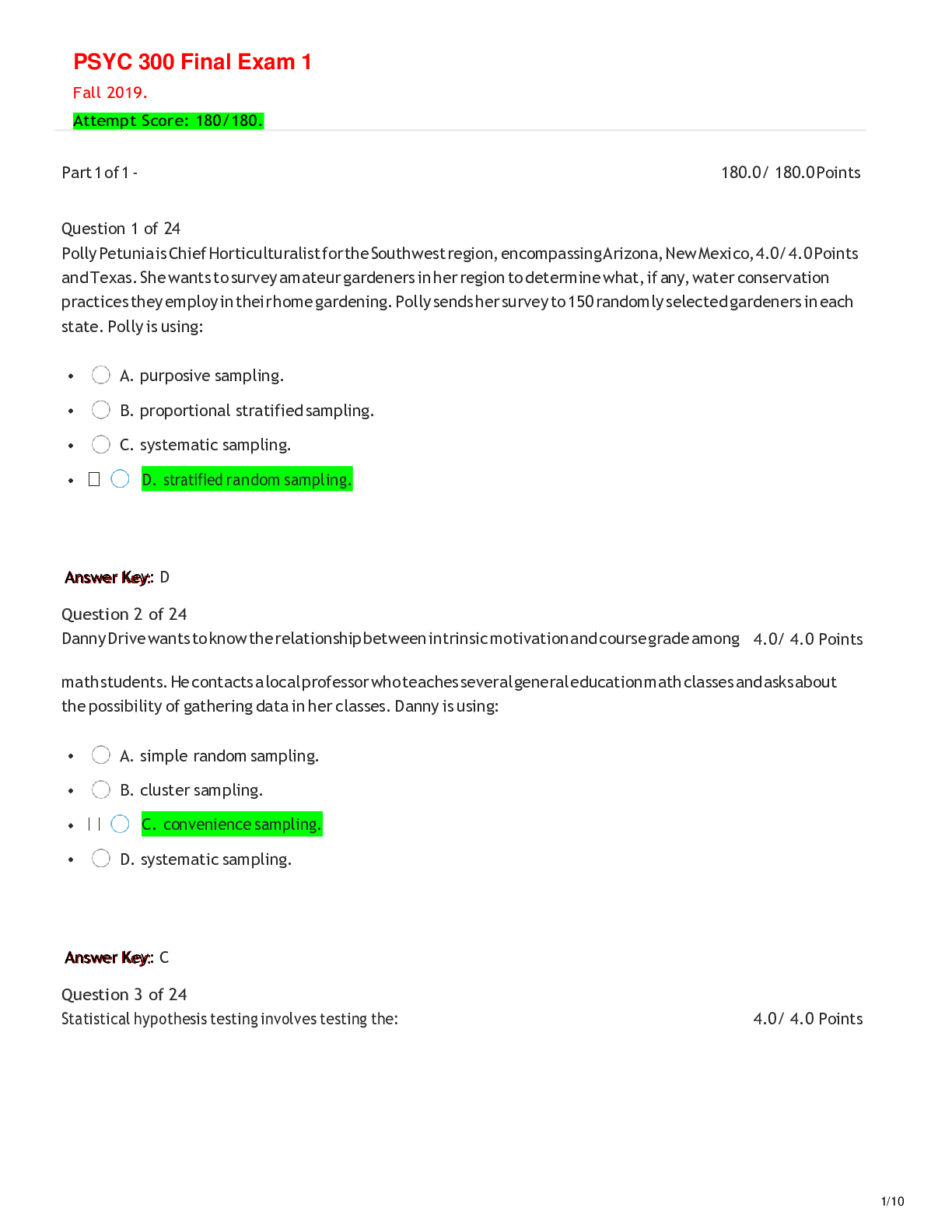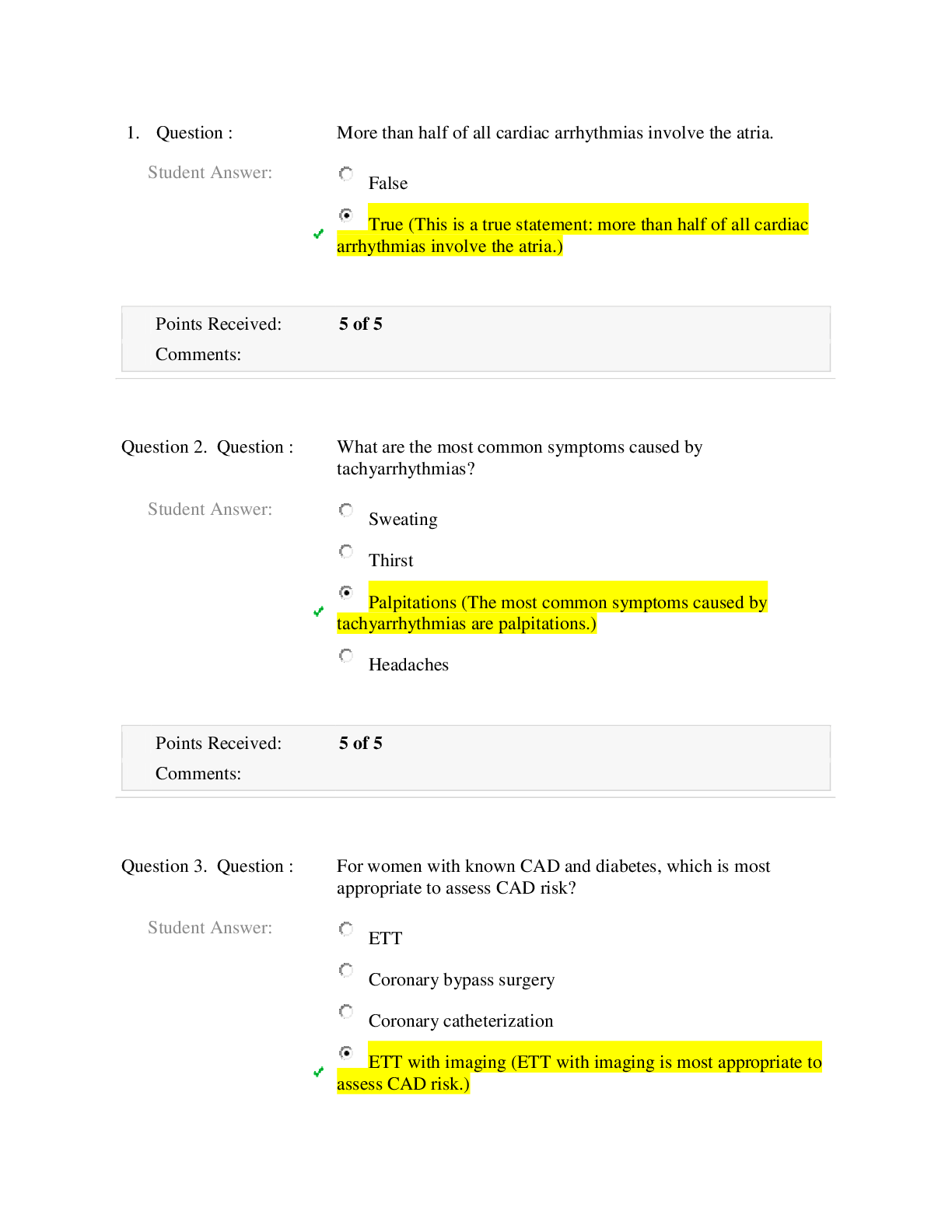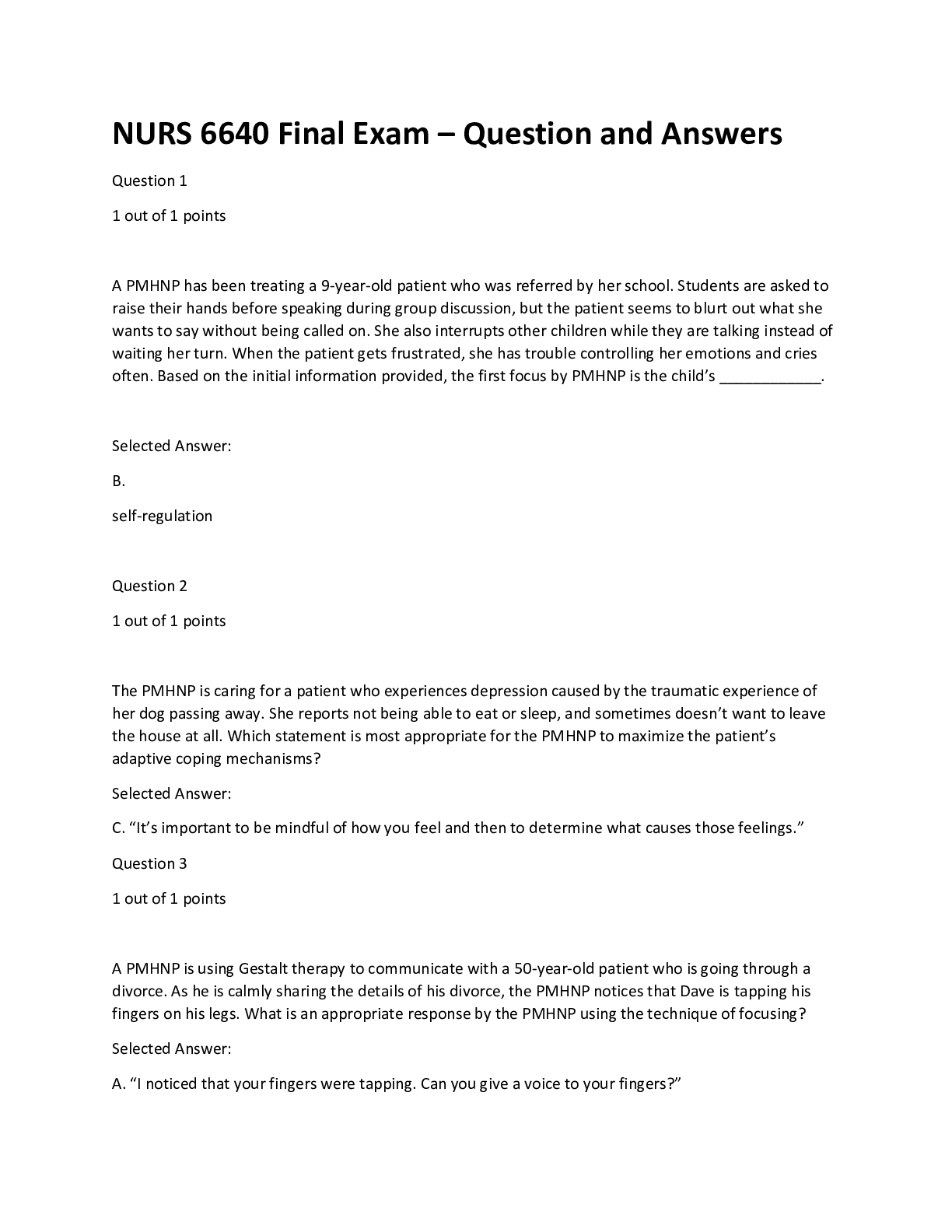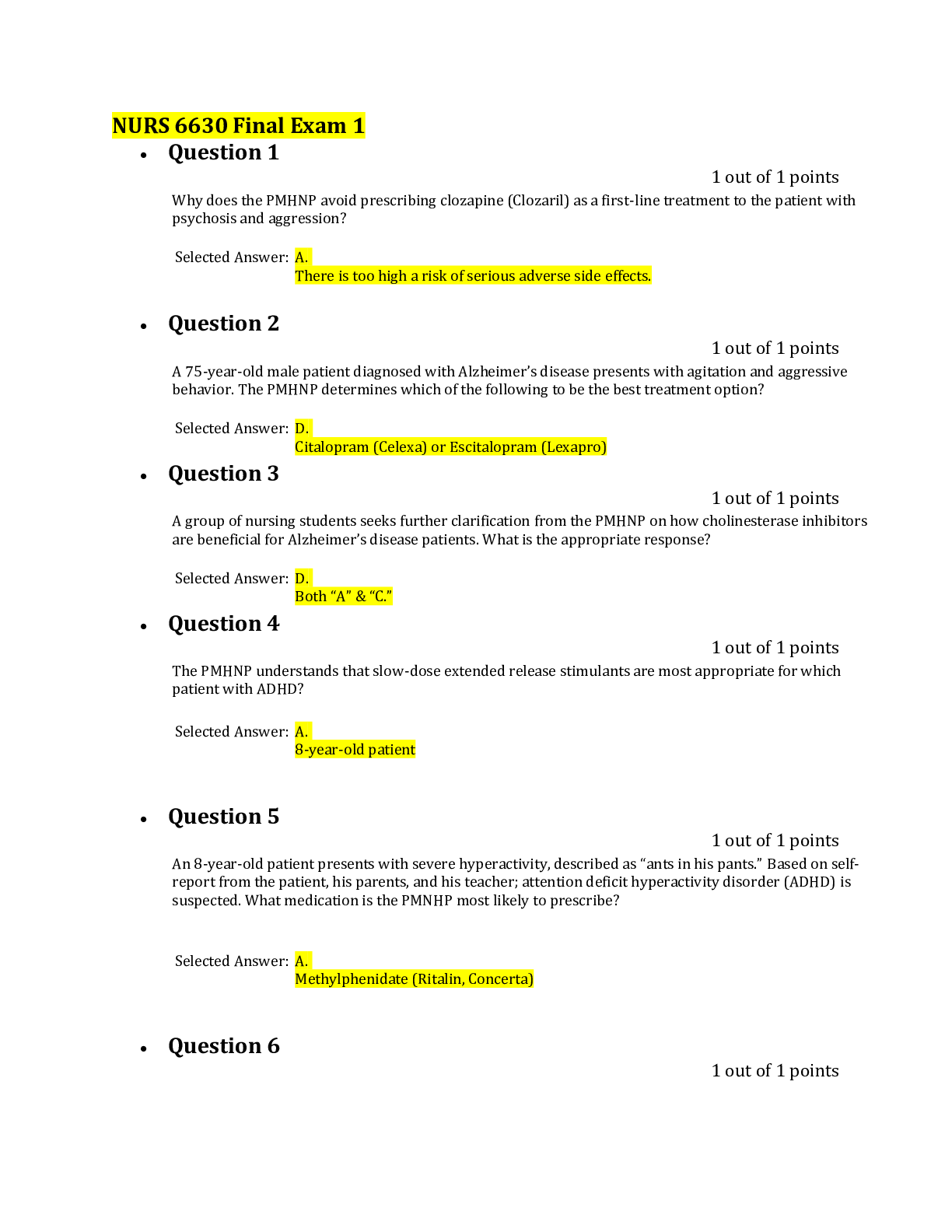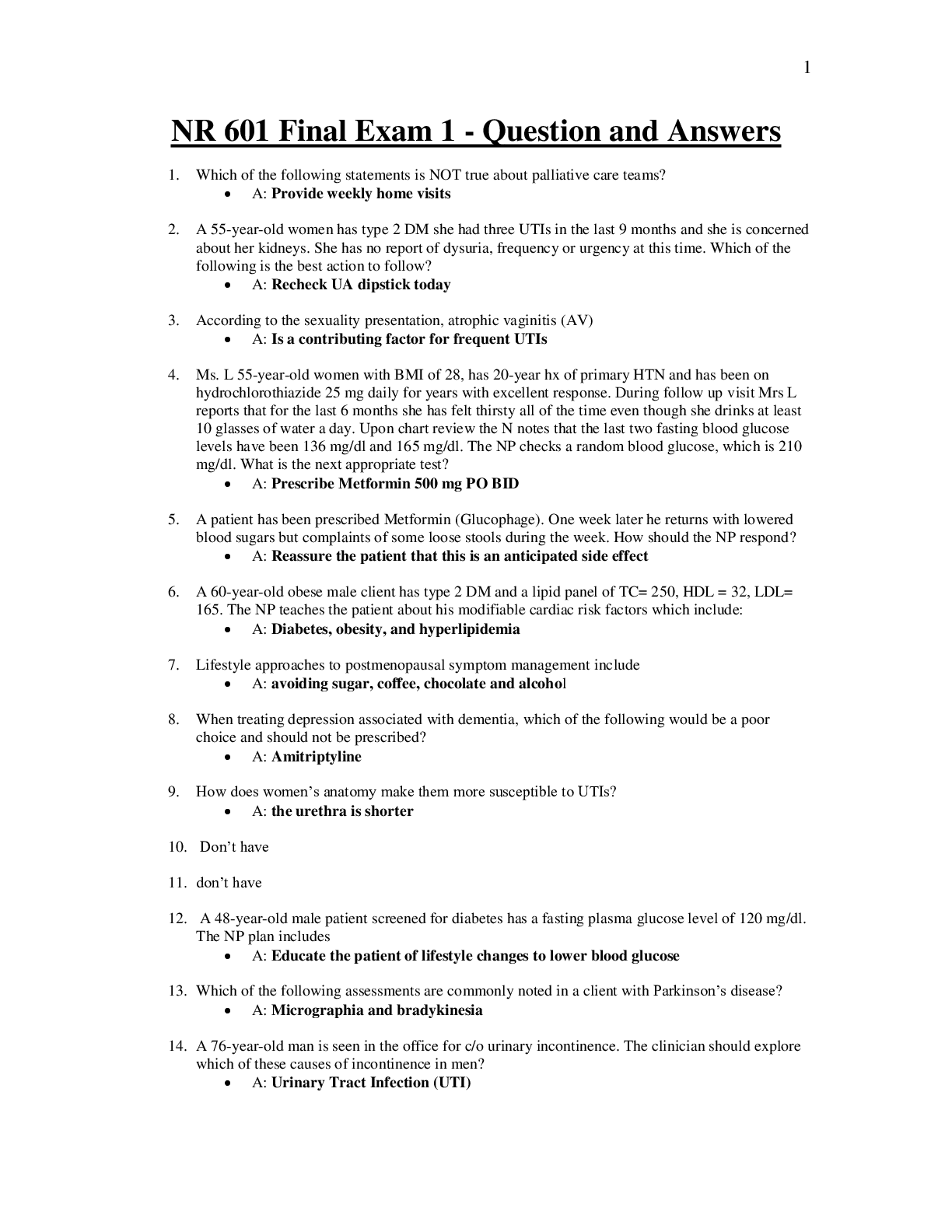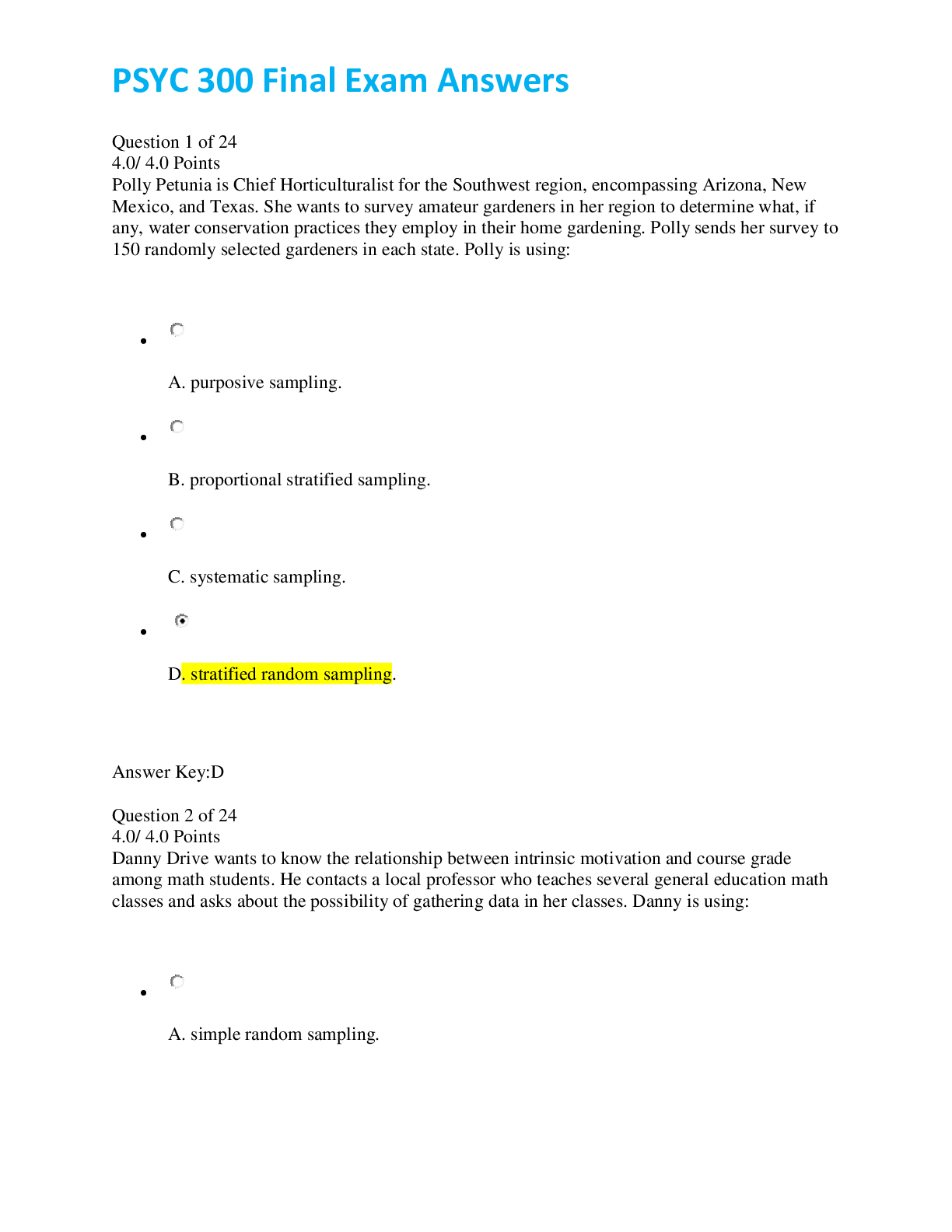NSG 6430 Final Exam 1 - Womens Health_LATEST 2020 (Q&A),100% CORRECT
Document Content and Description Below
Elizabeth was evaluated and diagnosed with a primary outbreak of genital herpes in the clinic today. The treatment plan for Elizabeth will include a prescription for: A) Ribavirin B) In... dinavir C) Valacyclovir D) Cyclosporine Save Question 2 (2.5 points) Elizabeth was recently diagnosed with genital herpes after having unprotected intercourse with a new partner. The nurse practitioner explains to Christine that the incubation period for HSV Type 2 is approximately: Question 2 options: A) 4 to 7 days up to 4 weeks B) 24 hours C) 24 days D) 1 to 3 days up to 14 days Save Question 3 (2.5 points) Kristin returns to the clinic for follow-up on STI results. The nurse practitioner informs her the Chlamydia test was positive. Which of the following agents will the nurse practitioner prescribe for treatment? Question 3 options: A) Amoxicillin B) Metronidazole C) Azithromycin D) Tinidazole Save Question 4 (2.5 points) The nurse practitioner student is studying the CDC guidelines for treating sexually transmitted infections. Which of the following agents is recommended for Gonorrhea treatment? Question 4 options: A) Ceftriaxone B) Doxycycline C) Ketoconazole D) Amoxicillin Save Question 5 (2.5 points) A 30-year-old woman presents without symptoms but states that her male partner has dysuria without penile discharge. Examination of the woman reveals a friable cervix with yellow discharge from the cervical os. This description is most consistent with an infection caused by: Select all that apply. Question 5 options: A) Chlamydia trachomatis B) Neisseria gonorrhoeae C) Human papilloma virus (HPV) D) Trichomonas vaginalis Save Question 6 (2.5 points) Karen was diagnosed with trichomoniasis by her primary care provider and treated with: Question 6 options: A) Metronidazole 500 mg po BID x 7 days (If single-dose metronidazole treatment fails and reinfection is excluded, metronidazole 500 mg orally twice a day for 7 days should be prescribed.) this is the correct answer if first treatment doesn’t work B) Terconazole vaginally Q HS x 5 days C) Azithromycin 1 gm po x 1 dose D) Bactrim DS ipo Q 12 hours x 3 days Save Question 7 (2.5 points) A 24-year-old woman presents with a 1-week history of thin, greenish yellow vaginal discharge with perivaginal irritation. Physical examination findings include vaginal erythema with petechial hemorrhages on the cervix, numerous white blood cells, and motile organisms on microscopic examination. These findings most likely represent: Question 7 options: A) motile sperm with irritative vaginitis B) trichomoniasis C) bacterial vaginosis D) condylomaacuminatum Save Question 8 (2.5 points) For patients needing topical treatment for vulvovaginitis caused by Candida albicans, the nurse practitioner will prescribe: Question 8 options: A) metronidazole gel B) clotrimazole cream C) hydrocortisone ointment D) clindamycin cream Save Question 9 (2.5 points) The nurse practitioner understands that women with bacterial vaginosis typically present with: Question 59 options: A) vulvitis B) pruritus C) dysuria D) malodorous discharge Save Question 10 (2.5 points) The U.S. Preventative Services Task Force (USPSTF) recommends ____________ of folic acid supplement daily at least one month before conception for all women with average risk for neural tube defects. Question 10 options: A) 8000 mg B) .4 to .8 mg C) 4 to 8 mg D) 4000 mg Save Question 11 (2.5 points) The American College of Obstetrician &Gynecologists recommend that all pregnant women be offered aneuploidy screening before 20 weeks gestation. This test identifies women whose fetuses are at increased risk for which of the following? Select all that apply. Question 11 options: A) Trisomy 11 B) Trisomy 13 C) Trisomy 18 D) Trisomy 21 Save Question 12 (2.5 points) An important part of patient education for the patient with bacterial vaginosis who is receiving a prescription for oral Metronidazole is: Question 12 options: The patient should be treated prophylactically for a yeast infection. The medication may cause constipation. Avoid alcohol for 48 hours after completing medication. The patient's partner will need treatment also. Save Question13 (2.5 points) For the patient with chronic bacterial vaginosis, the nurse practitioner will prescribe: Question 13 options: A) Metronidazole 500 mg po weekly for 2 months B) Metronidazole 500 mg po BID x 7 days C) Metronidazole gel .75% vaginally BID x 5 days D) Metronidazole gel .75% vaginally 1-2 times a week for 4 to 6 months Save Question 14 (2.5 points) The nurse practitioner's exam findings on a patient with vaginal Candidiasis is positive for all of the following except: Question 14 options: A) erythematous vaginal mucosa B) thick, white, curd-like vaginal discharge C) vaginal ph of 7 D) hyphae visualized on wet prep Save Question 15 (2.5 points) A woman arrives at the clinic for a pregnancy test. Her last menstrual period (LMP) was February 14, 2017. Using Nageles Rule, what is the client's expected date of birth (EDB)? Question 15 options: A) September 17, 2017 B) November 7, 2017 C) November 21, 2017 D) December 17, 2017 Save Question 16 (2.5 points) Which documentation on a woman's chart on postpartum day 14 indicates a normal involution process? Question 16 options: A) Moderate lochia rubra B) Breasts soft and symmetrical C) Fundus below the symphysis pubis and nonpalpable D) Episiotomy pink and healing Save Question 17 (2.5 points) The nurse practitioner understands that the hormone, __________, remains elevated in breastfeeding women in the postpartum period. Question 17 options: A) Estrogen B) Progesterone C) Prolactin D) Human placental lactogen Save Question 18 (2.5 points) The nurse practitioner is recommending daily Calcium supplementation of ___________ to her female patients that are older than 50 years of age. Question 18 options: A) 800 mg B) 1000 mg C) 1200 mg D) 1500 mg Save Question 19 (2.5 points) Osteoporosis is diagnosed when the patient's bone density is more than ______ standard deviation(s) below the average bone mass for women younger than 35 years old. Question 19 options: A) 1 B) 1.5 C) 2.5 D) 4 Save Question 20 (2.5 points) Based on the latest ACOG guidelines, the nurse practitioner understands that the recommended time to initiate screening for cervical cancer in women is: Question 20 options: A) prior to becoming sexually active B) at age 18 years C) at age 21 years D) three years after first sexual intercourse Save Question 21 (2.5 points) The nurse practitioner understands the following lifestyle approaches may be used to prevent osteoporosis after menopause: Select all that apply. Question 21 options: Limit alcohol intake Performance of regular weight-bearing activities Increase caffeine consumption Adequate calcium &vitamin D intake Save Question 22 (2.5 points) What is the primary role of a nurse practitioner in the research process? Question 22 options: A) Designing research studies B) Collecting data for other researchers C) Identifying researchable problems D) Seeking funding to support research studies Save Question 23 (2.5 points) Whether you order diagnostic testing or refer the patient to an HIV-specific facility, laboratory confirmation is rendered. The test confirming HIV infection is _____________. Question 23 options: A) Western blot assay B) enzyme-linked immunosorbent HIV RNA C) CD4+ lymphocyte count D) quantitative plasma HIV RNA Save Question 24 (2.5 points) The nurse practitioner is examining a twenty-nine-year-old female with a three day history of dysuria and urinary frequency. On examination, the patient is positive for suprapubic tenderness and negative for costovertebral angle (CVA) tenderness. This most likely represents which of the following? Question 24 options: A) Pyelonephritis B) Cystitis C) Ectopic pregnancy D) Asymptomatic Bacteriuria Save Question 25 (2.5 points) A patient has been diagnosed with trichomoniasis. Which of the following single dose medications would be the best option? Question 25 options: A) Azithromycin 1 g B) Clindamycin 300 mg C) Ofloxacin 500 mg D) Metronidazole 2 g Save Question 26 (2.5 points) When educating patients about the use of combination oral contraceptive medications, they should be advised that pregnancy is prevented primarily by ____________. Question 26 options: A) cervical mucus thinning B) inflammation of the endometrium C) ovulation suppression D) decreased fallopian tube motility Save Question 27 (2.5 points) A twenty-four-year-old female presents to the office with a complaint of a “yucky” vaginal discharge. On exam, a milky vaginal discharge is noted. A wet mount preparation reveals a positive whiff test and 75% clue cells. There were no trichomonads or WBCs visualized. Which of the following would be the most likely diagnosis in this patient? Question 27 options: A) Bacterial vaginosis B) Herpes simplex C) Chlamydia D) Cystitis with cervicitis Save Question 28 (2.5 points) A fifty-five-year-old postmenopausal female patient presents with pain in the upper outer quadrant of her left breast for over one month now. The best course of action would be to _______. Question 28 options: A) reassure the patient that pain is often not a presenting symptom of breast cancer B) teach the patient breast self-examination C) order laboratory studies as most likely this is secondary to a hormonal fluctuation D) perform a breast examination and order a mammogram Save Question 29 (2.5 points) A thirty-nine-year-old female has just completed a course of Amoxicillin for the treatment of streptococcal pharyngitis. Her LMP was two weeks ago and reports that it was normal for her. On physical examination, there is some erythema of the external genitalia with a small amount of white discharge. The microscopic wet prep examination reveals few clue cells but an abundance of budding hyphae. There are no WBCs present. Considering the differential diagnoses and results of the microscopic examination, which of the following would be the most appropriate treatment? Question 29 options: A) Metronidazole 500 mg BID for seven days B) OTC hydrocortisone 1% cream TID C) Fluconazole 150 mg tablet as a onetime dose D) Erythromycin 500 mg TID for ten days Save Question 30 (2.5 points) A forty-nine-year-old female patient presents with a chief complaint of dark, watery brown vaginal discharge. Part of the differential diagnosis includes that of cervical cancer. Which of the following best describes what might be visualized on physical examination in patients with cervical cancer? Question 30 options: A) Ulcerated firm cervix B) Lower abdominal pain that is vague C) Enlarged tender femoral lymph nodes D) Soft, still shaped cervix Save Question 31 (2.5 points) A twenty-five-year-old female presents with vaginal irritation and discharge. On examination, the cervix is easily friable and erythematous. There is no adnexal tenderness. The wet prep (wet mount) microscopic examination reveals mobile protozoa on the normal saline slide. This most likely represents _________. Question 31 options: A) trichomoniasis B) mucopurulent cervicitis C) bacterial vaginosis D) gonorrhea Save Question 32 (2.5 points) A twenty-two-year-old female presents with an initial onset of herpes simplex on the external genitalia. During the patient education, which of the following statements is most important to include? Question 32 options: A) Cesarean section will be necessary for any pregnancy and delivery. B) Antiviral medications will be useful in treating and curing an outbreak. C) The sexual partner will not contract herpes if lesions are not present. D) Symptoms of the initial outbreak of the lesions are typically worse than subsequent outbreaks. Save Question 33 (2.5 points) Follicle-stimulating hormone (FSH) is released from the anterior pituitary gland and is responsible for which of the following normal physiologic response of the female menstrual cycle? Question 33 options: A) Breast milk production B) Stimulation of ovarian follicles C) Maturation of ovarian follicles D) Luteinizing hormone (LH) inhibition Save Question 34 (2.5 points) A thirty-two-year-old patient comes in for a workup of infertility. During the history, the nurse practitioner suspects that the patient may be experiencing anovulatory cycles. In order to confirm ovulation, which of the following tests would be most appropriate to order? Question 34 options: A) Endometrial biopsy B) Basal body temperature C) Hysterosalpingogram D) Postcoital testing Save Question 35 (2.5 points) A nurse practitioner is performing a wet mount with potassium hydroxide (KOH) to assist with a diagnosis in a woman experiencing vaginal discharge. Which of the following would this confirm? Question 35 options: A) Herpes simplex B) Trichomonas C) Candidiasis D) Chlamydia Save Question 36 (2.5 points) A nurse practitioner is completing a speculum exam on a female patient. Which of the following findings would be considered a normal surface characteristic of the cervix? Question 36 options: A) Small, yellow, raised area on the cervix B) Friable, bleeding tissue opening of the cervical os C) Red patch areas with occasional white spots D) Irregular, granular surface with red patches Save Question 37 (2.5 points) There are several phases to the menstrual cycle. What phase begins with menses cessation and ends with ovulation? Question 37 options: A) Ovulatory phase B) Follicular phase C) Proliferative phase D) Luteal phase Save Question 38 (2.5 points) A nurse practitioner is participating in a women’s health fair. When educating the women about risk factors for breast cancer, which of the following statements is incorrect? Question 38 options: A) Pregnancy after age of thirty-five years B) Late menopause after age of fifty-seven years C) History of maternal breast cancer D) Fibrocystic breast disease Save Question 39 (2.5 points) The first line treatment of severe menstrual cramps that have been occurring for four months in a patient with primary dysmenorrhea includes which of the following? Question 39 options: A) Acetaminophen B) Ibuprofen C) Combination hormone replacement therapy (HRT) D) Amitriptyline Save Question 40 (2.5 points) Which of the following choices represents a disorder of the reproductive tract that causes pain, erythema, dyspareunia, and a perineal mass? Question 40 options: A) Syphilis B) Bartholin’s cyst C) Labial adhesion D) Herpes simplex type 2 Save Question 41 (2.5 points) A woman is concerned that she may develop breast cancer and is discussing her concerns with the nurse practitioner. Which of the following is not an associated risk factor for this? Question 41 options: A) Late menarche B) Family history C) Nulliparity D) Late menopause Save Question 42 (2.5 points) A sixty-one-year-old thin, Caucasian female presents to your practice for a well-woman examination. She remarks that she feels like she is shrinking over the past year, despite keeping active and incorporating sources of calcium in her diet. Which of the following is not a risk factor for osteoporosis? Question 42 options: A) Excessive exercise B) History of maternal osteoporosis C) Smoking D) Using hormone therapy Save Question 43 (2.5 points) A thirty-five-year-old woman, presents with a six-month history of hypermenorrhea, backache, and pelvic pressure. On examination, you discover a twelve-week size uterus with irregular contour. Which of the following does this most likely represent? Question 43 options: A) Uterine cancer B) Dysfunctional uterine bleeding (DUB) C) Uterine fibroid D) Fecal impaction Save Question 44 (2.5 points) It is known that a woman who is menopausal has an increased risk of heart disease. Which of the following lipid changes occur with estrogen withdrawal in menopause? Question 44 options: A) Decrease in HDL, LDL, and triglycerides B) Decrease in HDL, LDL, and increase in triglycerides C) Increase in HDL with a decrease in LDL and triglycerides D) Decrease in HDL with an increase in LDL and triglycerides Save Question 45 (2.5 points) Which of the following is true regarding education of a forty-two-year-old woman diagnosed with a uterine myoma? Question 45 options: A) Myomas usually does not resolve with menopause. B) Myomas will decrease with the withdrawal of estrogen. C) Hysterectomy is the treatment of choice. D) Myomas are never responsible for uterine bleeding. Save Question 46 (2.5 points) Sheryl, a seventeen-year-old, complains of a vaginal discharge for the past month. When she wipes after urinating, there is "white stuff" on the tissue. Sheryl denies urinary problems but has had some genital itching, but no odor. She also denies sexual activity. Her vaginal discharge is most likely a result of ______. Question 46 options: A) a yeast infection B) a chlamydia infection C) retained foreign body D) physiologic leukorrhea Save Question 47 (2.5 points) Urinary tract infections are commonly seen in primary care. A twenty-five-year-old female presents with a new onset of dysuria and suprapubic pain for the last twenty-four hours. The examination reveals only mild tenderness without any peritoneal signs on the lower abdomen. A urinalysis reveals the presence of WBCs. The urine is sent for a culture and sensitivity. In addition to Escherichia coli one might typically expect to see the presence of which bacterium? Question 47 options: A) Klebsiella B) Staphylococcus aureus C) Staphylococcus saprophyticus D) Pseudomonas Save Question 48 (2.5 points) The pituitary gland is responsible for a variety of functions with respect to hormonal regulation and is composed of two lobes, the anterior and posterior sections. Which of the following list of hormones are secreted by the anterior pituitary gland? Question 48 options: A) Growth hormone (GH) and thyroid-stimulating hormone B) Prolactin and T4 C) Follicle-stimulating hormone (FSH) and T3 D) Luteinizing hormone (LH) and oxytocin Save Question 49 (2.5 points) The nurse practitioner is counseling a patient on the side effects associated with some birth control methods. The woman complains that she has developed acne and hirsutism while taking oral contraceptives. The nurse practitioner understands that these changes result from _____. Question 49 options: A) increased estrogen levels B) decreased estrogen levels C) increased free androgens D) decreased free androgens Save Question 50 (2.5 points) You are meeting with twenty-two-year-old Emily to discuss birth control options. She has tried “the pill” in the past but failed to take it regularly. She is interested in depo because she only has to come in every three months for a shot. She also heard that one does not get a period on depo, and she likes the thought of that. Which of the following would be a specific consideration with depo that you would need to discuss with Emily based on her desires for a birth control method? Question 50 options: A) Depo offers no protection from STIs. B) Depo can cause break through bleeding up to the second or third injection C) As with any hormonal birth control, changes in weight can occur. D) Depo does not offer pregnancy protection for those who are obese. [Show More]
Last updated: 1 year ago
Preview 1 out of 27 pages
Instant download
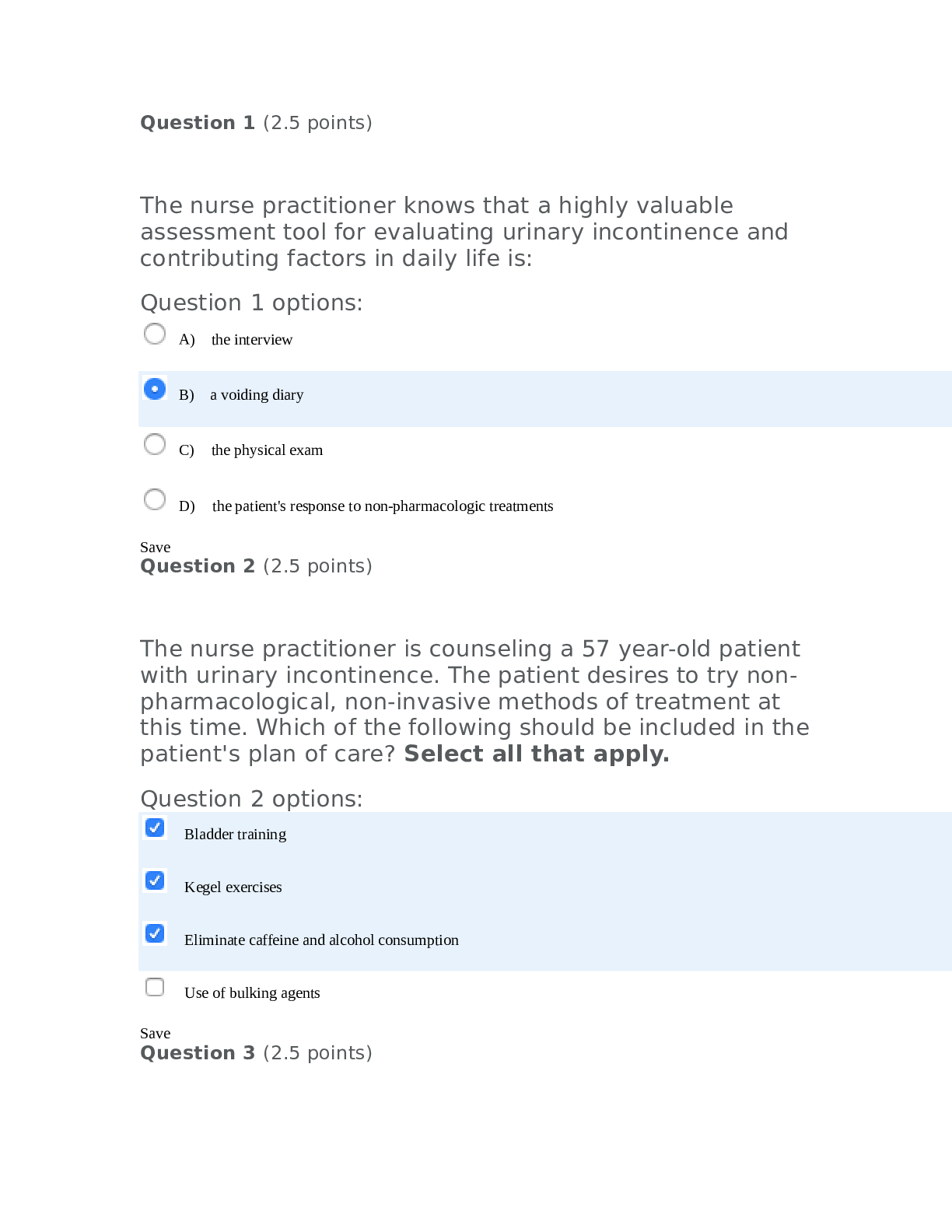
Buy this document to get the full access instantly
Instant Download Access after purchase
Add to cartInstant download
Reviews( 0 )
Document information
Connected school, study & course
About the document
Uploaded On
Oct 26, 2020
Number of pages
27
Written in
Additional information
This document has been written for:
Uploaded
Oct 26, 2020
Downloads
0
Views
48














